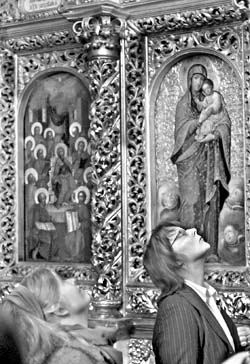Diplomatic pilgrimage
Foreign ambassadors’ wives visit Ukraine’s “heaven on earth”
In spite of the bad weather, the wives of several foreign ambassadors met in the small yard at the entrance to the Kyivan Cave Monastery. This was no official reception. Rather, the sizable group of women, who are participating in a project tentatively called the Women’s Parlor, came here to spend some time in Ukraine’s spiritual center.
The 900-year-old Trinity Church, one of Ukraine’s most outstanding cultural monuments, was the first item on the guests’ agenda. Arm in arm, smiling, and discussing everything under the sun, the women entered the church. In bygone days pilgrims were not allowed inside under any circumstances, and even monks prayed here only once a year on Holy Trinity Day.
The church’s many wonders arose before their eyes-the 270-year-old Baroque iconostasis, wall frescoes, the miracle-working icon, which was sold for two loaves of bread in 1933, and the image of St. Nicholas, the church’s founder, carved in one of its stone walls. Irina Panteleeva, the wife of the Russian ambassador to Ukraine, shared her impressions: “There is everything here, both inner and outward beauty.”
After a cursory acquaintance with this “heaven on earth,” as the clergy sometimes calls the Trinity Church, the members of the Women’s Parlor moved to the belfry. Svyryd Holokhvastov, a character from the movie Za dvoma zaitsiamy (After Two Hares), said that if you have not been on top of the belfry in the Kyivan Cave Monastery, you have not seen Kyiv. The diplomats’ wives must also have wanted to see Kyiv spread out at their feet, but were stopped by on-going renovations.
However, they were able to attend an exhibit of church embroidery, where they saw the legendary canvas “Don’t cry for me, mother,” which was embroidered by Hetman Ivan Mazepa’s mother. In another room the guests saw Ukrainian church treasures-chalices and pyxes, everything that is indispensable for a church service.
In the Museum of Ukrainian Decorative Art the group of women of different nationalities saw all the symbols of Ukrainian life. The guide began the tour at the display of rushnyky, embroidered towels that have a sacred meaning for Ukrainians, and then moved on to items of everyday use-powder flasks, Cossack pipes, shelves for icons, items chiseled out of wood, and tableware. At the display of clay tiles, bottles, and flasks, the guide took the opportunity to explain to the visitors the meaning of the Cossack expression poboroty mykhailyka, which means ‘to drink some vodka.”
The foreign guests were invited to view a display of Ukrainian national costumes, including Hutsul clothing, bridal attire, and clothing for married men and women, as well as elderly people-the entire history of Ukrainian fashion until the early part of the 20th century. Standing next to one of the display items, Anar Rusnakova, the wife of the Slovak ambassador to Ukraine, told her colleagues that she had recently purchased a Ukrainian skirt that can be tucked under the belt. The guide responded by saying that this feature of traditional clothing for Ukrainian girls is not only an element of coquetry but an important practical detail-women tucked up their skirts to keep them out of the way while they worked.
After viewing the costumes, the women went to see the paintings of Kateryna Bilokur. They listened to a concise version of the talented painter’s biography: she was a simple woman who had never studied painting or any sciences. The story of the lonely genius who did not find understanding in her milieu must have appealed to the visitors because they spent more time in the Bilokur room than anywhere else in the museum.
Moving from theory to practice, the members of the Women’s Parlor were invited to take part in several specially organized classes: Ukrainian Easter-egg painting, Petrykivka painting (a traditional type of Ukrainian decorative painting featuring images of plants and animals), contemporary artistic textiles, and the modeling clay craft. Mechthild Schafers, the wife of the German ambassador, and Sibel Iscan, representing Turkey, were the first to try their hand at Petrykivka painting. The young female teachers patiently demonstrated how to use the brush to produce bright flowers. After several attempts at reproducing this complicated technique, the German ambassador’s wife told The Day: “It’s really not that easy to paint all these flowers and leaves. But I will consider taking up Petrykivka painting. Maybe I’ll ask the girls who demonstrated this original technique to teach me how to paint better. Of course, it takes a lot more time than five minutes.”
The spouses of the Slovak and Estonian ambassadors were in their element when they were painting Ukrainian Easter eggs. In their hands ordinary eggs turned into bright Easter eggs with red backgrounds and white ornamentation. Marina Hein of Estonia was the first to complete her task. Holding the Easter egg she had just painted, she shared her impressions: “This is extraordinary, inspiring. I am thinking about purchasing two Easter egg kits. I would like my children to take this course. It was not even difficult for me because I was so wrapped up in the process.”
After the practical course the guests were treated to refreshments set out buffet-style. The Women’s Parlor invited all the painting experts with whom the ambassadors’ wives were now on friendly terms.
Olha Ohryzko, the wife of Ukraine’s Minister of Foreign Affairs, who organized the excursion, said: “I believe that this event was a success mainly because it took place right before Easter. That’s why we chose the Kyivan Cave Monastery and the museum that reflects our spiritual culture in the most comprehensive way-the Museum of Ukrainian Decorative Art.”






